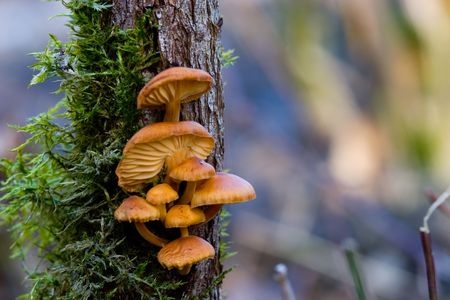Velvet Shank - Flammulina velutipes

Common Names: Velvet Shank, Enoki, Enokitake, Golden Needle Mushroom, Lily Mushroom, Seafood Mushroom, Winter Mushroom, Winter Fungus, Velvet Foot, Velvet Stem, Jinzhengu (Chinese), Jingu (Chinese), Paengi Beoseot (Korean), Kim Cham (Vietnamese), Tram Vang (Vietnamese), Flammulina velutipes
Latin Name: Flammulina velutipes
Origin: Asia, North America
Short Introduction
In Japan, Velvet Shank is one of the most popular edible mushrooms, with enthusiastic support and advocacy from Japanese consumers. It is typically cultivated in cool rooms in small clusters, with elongated mycelium encouraged by increased carbon dioxide and decreased light exposure. The mushroom’s unusual shape also makes harvesting easier. The optimal growing medium includes potato dextrose agar, malt yeast agar, flake agar, or even dog food agar. The substrate of choice is wood from trees such as oak, alder, willow, birch, or beech. The ideal substrate pH should be around 5 to 6. Fruiting occurs from March through December.
Detailed Description
Japanese mushroom with immunomodulating effects.
Botanical Information
The cap of the Velvet Shank ranges from light brown (honey-colored) to orange, measuring 1–7 cm in width. It is sticky (when fresh), smooth, and either convex or flat, with whitish, thin, closely spaced gills. The color fades as it ages. The mycelium is white and longitudinal with light brown and golden spots that expand over time. The mushroom produces white to yellowish spores. The stem is characteristically velvety, dark brown (older specimens become even darker), measuring 2–11 cm long and 3–10 mm wide, sometimes wider at the base. Growth halts during freezing but resumes when temperatures rise, a trait similar to Oyster Mushroom and Jew's Ear (also found in our herbarium). It is a saprotrophic fungus with nearly odorless and tasteless fruiting bodies.
Origin and Distribution
Velvet Shank is widespread throughout the temperate regions of the Northern Hemisphere, with highest popularity in Asia and North America (where it is also cultivated), and has also been introduced to Australia. It can be found growing on a variety of deciduous trees including maple, hornbeam, hawthorn, beech, apple, black locust, linden, elm, horse chestnut, alder, dogwood, ash, soapberry, poplar, willow, elder, mulberry, walnut, oak, and currant. It is commonly cultivated on these trees as well.
Usage / Dosage
One of the key compounds in Velvet Shank, ergothioneine, is well-researched for its antioxidant activity in animal models. Another major compound, proflamin, demonstrated inhibitory effects on tumor growth in animals, reportedly increasing lifespan by about 85%. Several compounds found in Enoki (a common name for Velvet Shank) have been shown in animal studies to reduce the growth and spread of cancer cells, particularly some types of sarcoma.
Ergothioneine’s strong antioxidant potential is widely recognized, and it is believed to support immune system health. Some Japanese research teams are pursuing the idea of developing anticancer vaccines based on high doses of these compounds (additionally utilizing the polysaccharide flammulin). The epidemiologist Wang and colleagues noted that regular consumption of Enoki mushrooms might correlate with lower cancer prevalence in Japanese populations living near Nagano, an area known for its traditional use of the mushroom. This may also reflect overall healthy lifestyle and dietary habits.
A research group in Singapore reported (in the first study since 2005) the presence of a large number of proteins collectively known as “five,” which regulate and stimulate the immune system in response to infections.
The complex mixture of active compounds also includes lectin and beta-D-glucan. Lectin is described as an immunomodulatory protein that helps increase antioxidant production. In combination with beta-glucan, these two compounds are thought to improve immune balance and support liver health (according to Dr. Wichers’s research group). Some studies describe antibiotic effects (especially against Staphylococcus aureus) and antiviral activity.
In Japan, Velvet Shank is recommended for neurodegenerative diseases such as dementia and Alzheimer’s disease as a preventative measure, is used for its anti-inflammatory effects, and is prescribed or recommended by both healers and some medical professionals for detoxification and cardiovascular protection. Older Chinese and Japanese studies (from 1987 and 1973, among others) investigated Flammulina velutipes for the prevention of gastrointestinal ulcers, the formation of superficial gastric lesions, and liver disorders.
There are no records of toxic effects or poisoning. However, chefs and food connoisseurs recommend steaming the mushroom at 100°C for at least 20 minutes to inactivate the cardiotoxic protein flammutoxin.
Active Compounds
The most important active compounds include the water-soluble polysaccharide flammulin, ergothioneine, beta-D-glucan, and lectin. Velvet Shank is rich in amino acids, particularly lysine (calming for the central nervous system, and may support mood). Other identified compounds include D-arabinitol, ergosta-5,7,22-trien-3beta-ol, epidioxy-ergosta-6,22-dien-3beta-ol, trihydroxy-ergosta-7,22-dien-6-one, hydroxymethyl-2-(1-methylethenyl)-1-cyclohexanol, hemisceramide, 1,3-dilinolein, oleic acid, and linoleic acid.
Traditional Dosage
Most scientific publications recommend 500–750 mg of extract, with some sources advising 625 mg extract daily. For adults, several grams of mushroom per day are typically suggested, with the range adjusted according to individual need and age.
